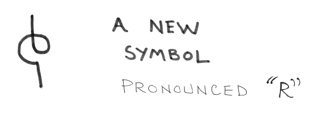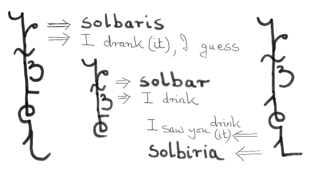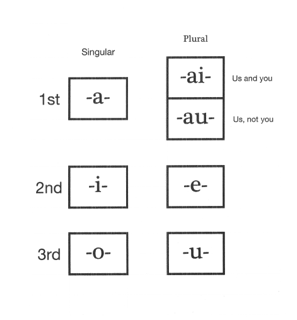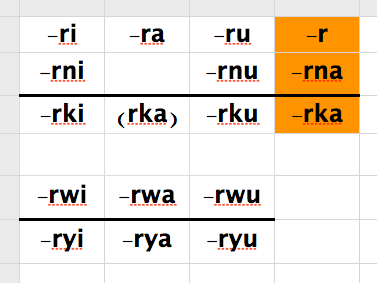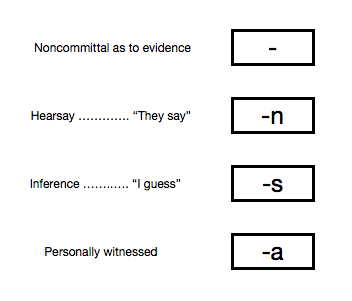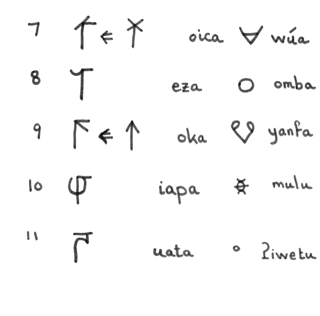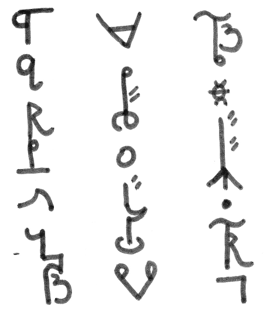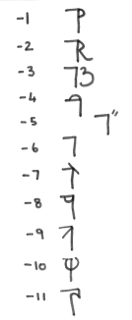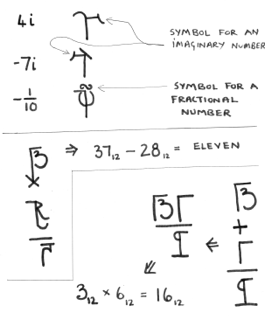Béu : Chapter 2
..... Pronouns
Below the form of the béu pronouns is the given for when the pronoun is the A argument.
..
| I | pás | we (includes "you") | yúas |
| we (doesn't include "you") | wías | ||
| you | gís | you (plural) | jés |
| he, she | ós | they | nús |
| it | ʃís | they | ʃís |
Because the person and number of the A or S argument is expressed in the actual verb. The above are usually dropped (however the third person pronoun is occasionally retained to give the distinction between human and non-human subject) so when the pronouns above are come across, it might be better to translate them as "I myself", "you yourself" etc. etc.
Below the form of the béu pronouns is the given for when the pronoun is the S or O argument. When they are used as an S arguments (i.e. with an intransitive verb), it might be better to translate these pronouns as "I myself", "you yourself" etc. etc.
| me | pà | us | yùa |
| us | wìa | ||
| you | gì | you (plural) | jè |
| him, her | ò | them | nù |
| it | ʃì | them | ʃì |
..
The above table is for S and O arguments, it fact we have another pronoun but this one only occurs as an O argument. When a action is performed by somebody on themselves we use tí to represent the O argument.
Just as in English, we do not say "*I hit me", but "I hit myself" ... in béu we do not say *pás pà timpari, but pás tí timpari.
It is a rule that tí must follow the A argument (if it is overtly expressed ... i.e. by a free-standing pronoun and not just in the verb)
LINGUISTIC JARGON ... "myself" is what is called a "reflexive pronoun". In English there are many reflexive pronouns (i.e. "myself", "yourself", "herself", etc. etc.) : in béu only one.
..
The possessive form of these pronouns are ...
..
| my | pàn | our | yùan |
| our | wìan | ||
| your | gìn | your (plural) | jèn |
| his, her | òn | their | nùn |
| its | ʃìn | their | ʃìn |
..
And we also have tín which is used if the possessor is the same as the subject of the clause.
Actually the n suffix is the locative. In the grammar, location and possession are marked identically.
..
..... Building up a noun phrase (NP)
..
Now we talk about the béu noun phrase (cwidauza). This can be described as ;-
Specicier1 Head Adjective2 Genitive3 Determiner4 Relative-clause5
1) A specifier is either a number or a word such as "all" (ù), some (é or éu), "any" (í), every (yú), "many", "a few".
HEAD
2) An adjective (moizana) ... not much to say about this one, you can string together as many as you like ... the same as in English.
3) A noun or pronoun that qualifies another noun (commonly called the Genitive in the Western linguistic tradition). Formed by suffixing -n to a normal noun makes it into a genitive.
4) Either dí "this", or dè "that".
5) This is a clause that qualifies the noun. It starts with the particle ʔà.
An interesting point is that in the absence of a "head", any of the other elements can act as the head.
The head is usually a noun but can also be an adjective. When you come across an adjective as head of a noun phrase, its meaning is "the person/thing that is "adjective" ".
..
..... The Specifiers
Called koiʒia in béu
koiʒi actually means "preface" as in "the preface to the book"
All words that can occur to the right of the head in a NP are called nandaua koiʒi or ... when talking about grammar ... usually just koiʒia
These words include the numbers from 1 to 1727, the words "few" and "many", and the words below.
..
| jù | no |
| í | any |
| é | some (singular) |
| éu | some (plural) |
| ù | all |
| yú | each/every |
..
NB ... é and éu, in certain circumstances can mean "what" or "who"
..
..... 64 Adjectives
Some adjectives = éu moizana
moizu = attribute, characteristic, feature
And following the way béu works, if there is an action that can be associated with noun (in any way at all), that noun can be co-opted to work as an verb.
Hence moizori = he/she described, he/she characterized, he/she specified ... moizus = the noun corresponding to the verb on the left
moizo = a specification, a characteristic asked for ... moizoi = specifications ... moizana = things that describe, things that specify
nandau moizana = an adjective, but of course, especially in books about grammar, this is truncated to simply moizana
| good | bòi* | bad | kéu |
| long | làu | short | lái |
| high, tall | hài | low, short | ʔáu |
| right, positive | lugu | left, negative | liʒi |
| white | ái | black | àu |
| young | sài | old (of a living thing) | gáu |
| clever, smart | jini | stupid, thick | tumu |
| near | nìa | far | múa |
| new | yaipe | old, former, previous | waufo |
| big | jutu | small | tiji |
| hot | fema | cold | pona |
| open | nava | close | mapa |
| simple, easy | baga | complex, difficult, hard | kaza |
| sharp | naike | blunt | maubo |
| wet | nuco | dry | mide |
| empty | fene | full | pomo |
| fast | saco | slow | gade |
| strong | yubu | weak | wiki |
| heavy | wobua | light | yekia |
| beautiful | hauʔe | ugly | ʔaiho |
| contiguous, touching | yotia | apart, separate | wejua |
| fat | somua | thin, skinny | genia |
| bright | selia | dull, dim | golua |
| thin | pilia | thick | fulua |
| east, dawn, sunrise | cúa | west, dusk, sundown | dìa |
| tight | taitu | slack, loose | jauji |
| neat | ilia | untidy | ulua |
| soft | fuje | hard | pito |
| wide/broad | juga | narrow | tisa |
| rough | gaʔu | smooth | sahi |
| deep | gubu | shallow | siki |
| right | sèu | wrong | gói |
In the above list, it can be seen that each pair of adjectives have pretty much the exact opposite meaning. However in béu there is ALSO a relationship between the sounds that make up these words.
In fact every element of a word is a mirror image (about the L-A axis in the chart below) of the corresponding element in the word with the opposite meaning.
| ʔ | ||||
| m | ||||
| y | ||||
| j | au | |||
| f | o | |||
| b | oi | |||
| g | i | |||
| d | ia | high tone | ||
| l | =========================== | a | ============================ | neutral |
| c | ua | low tone | ||
| s/ʃ | u | |||
| k | eu | |||
| p | e | |||
| t | ai | |||
| w | ||||
| n | ||||
| h |
* Note that the adverb version of this word is slightly irregular. Instead of boiwe it is bowe. People often shout this when impressed with some athletic feat or sentiment voiced ... bowe bowe => well done => bravo bravo
Also instead of keuwe we have kewe. People often shout kewe kewe kewe if they are unimpressed with some athletic feat or disagree with a sentiment expressed. Equivalent to "Booo boo".
Note ... The original idea of having a regular correspondence between the two poles of a antonym pair came from an earlier idea for the script. In this early script, the first 8 consonants had the same shape as the last 8 consonants but turned 180˚. And in actual fact the two poles of a antonym pair mapped into each other under a 180˚ turn.
..... The relativizer
The relativizer in béu is ʔà. This takes all the pilana the same as a normal noun.
the basket ʔapi the cat shat was cleaned by John.
the wall ʔala you are sitting was built by my grandfather.
the woman ʔaye I told the secret, took it to her grave.
the town ʔafi she has come is the biggest south of the mountain.
the lilly pad ʔalya the frog jumped was the biggest in the pond.
the boat ʔalfe you have just jumped is unsound
báu ʔás timpori glá rà ʔaiho = The man that hit the woman is ugly.
nambo ʔàn she lives is the biggest in town. báu ʔàn dog I shot, reported me to the police = the man whose dog I shot, reported me to the police*
báu ʔaho ò is going to market is her husband.
the knife ʔage he severed the branch is a 100 years old
The old woman ʔaji I deliver the newspaper, has died.
The boy ʔaco they are all talking, has gone to New Zealand.
When the relative clause is giving extra information, the relativizer in is ʔài and a slight pause comes before it.
There is another relativized in béu that refers back to a whole proposition. In English "which" is sometimes given this function. For example ...
1) ... John had completely forgotten his wedding anniversary which really annoyed his wife.
béu uses nài in a similar way to how which is used in the above example. Also the same shorthand form is used for nài and nái. However no misunderstanding is possible since nài always has a pause before it (how do I do a comma ?) and nái always is immediately after a noun.
..... The R-form of the verb
..
Now we should introduce the active forms of the verb. Also referred to as the R-forms. béu has quite a comprehensive set of tense/aspect markers. The active form of the verb is built up from the infinitive form (gomia). There is only one form of the infinitive.
We will discuss the most-used form of the verb in this section, the R-form. But first we should introduce a new letter.
This letter has not been mentioned so far because it doesn't occur in any words as such. It only occurs in the R-form of the verb.
So if you hear "r" or see the above symbol, you know you are hearing the main verb of a clause. (definition of a clause (semo) = that which has one "r" ... ??? )
O.K. ... the R-form is built up from the gomia*.
1) the final vowel is deleted from the gomia.
*Excepts in rare cases (see "Adjectives and how they pervade other parts of speech")
... Slot 1
..
2) one of the 7 vowels below is added.
LINGUISTIC JARGON ... In the Western linguistic tradition, these markers are said to represent "person" and "number". Person is either first, second or third person (i.e. I, you, he or she). In the béu linguistic tradition they are called cenʔo-markers. (cenʔo = musterlist, people that you know, acquaintances, protagonist, list of characters in a play)
These markers represent the subject (the person that is performing the action). Whenever possible the pronoun that represents the subject is dropped, it is not needed because we have that information inside the verb with the cenʔo-markers.
Notice that there are 2 entries that represent the 1st person plural subject (i.e. we). The top one must be used when the people performing the action included the speaker, the spoken to and possibly others. The lower one must be used when the people performing the action include the speaker, NOT the person spoken to and one or more 3rd persons.
Note that the ai form is used where in English you would use "you" or "one" (if you were a bit posh) ... as in "YOU do it like this", "ONE must do ONE'S best, mustn't ONE".
LINGUISTIC JARGON ... This pronoun is often called the "impersonal pronoun" or the "indefinite pronoun".
So we have 7 different forms for person and number.
..
... Slot 2
..
3) now one of the 16 markers shown below is added. 16 is quite a respectable number, as far as tense/aspect markers go.*
Now these markers represent what are called tense/aspect markers in the Western linguistic tradition. In the béu linguistic tradition, they are called gwomai or "modifications". (gwoma = to alter, to modify, to adjust, to change one attribute of something).
The table above has the gwoma arranged according to form. The two arrays below have the gwoma arranged according to meaning. The items below the solid line are the negatives of the items above. An orange background indicates the timeless tense. You can see I have one entry enclosed by brackets. That is because to give a negative present tense negative you would express it periphrastically ... you would use the tenseless negative -rka followed by the béu equivalent of "now" or "at the moment".
Looking at the upper table, you can see the first 3 columns differ by their vowel. These are the tenses ... i for the past, a for the present and u for the future.
-ri ... This is the plain past tense. This is most often used when somebody is telling a story (a narrative). For example "Yesterday I got up, ate my breakfast and went to school". All three verbs in this narrative use the plain past tense.
-ra ... Should only be used if the action is happening NOW. English uses "to be xxxing". For example doikara = I am walking ... (doika = to walk)
-ru ... This is the future tense.
-r ... This has no time reference. It might be used for timeless "truths" such as "the sun rises in the West" or "birds fly".
The next row has what is called the habitual aspect. English has a past habitual (i.e. I used to go to school), Often in English the plain form of the verb is used as a habitual (i.e. I drink beer). Actually in béu the pattern is broken a bit, in that -rna has NOTHING to do with the activity going on at the time of speech, it is actually a tenseless habitual. Also béu and English behave the same in the following way ... whereas by logic we should use doikarna in "I walk (to school everyday)", in fact doikar is used. doikarna would be used only if we were going on to MENTION some exception (i.e. but last tuesday Allen gave me a lift)
doikarna = "sometimes I walk, and sometimes I choose not to walk" or even "I usually walk". If you walked on every occasion that was possible, then you would use doikar
-rnu ... Now English doesn't have a future habitual. But if it did it would have a roll. For instance, suppose you have just moved to a new house and are asked "how will you get to the supermarket". In béu you would answer doikarnu.
The next row expresses the perfect tense.
While the perfect tense, logically this doesn't have that much difference from the past tense it is emphasising a state rather than an action. It represents the state at the time of speaking as the outcome of past events. We have this tense/aspect in English and it is realized as "have xxxxen". For example if you wanted to talk to John and you went to his office, his secretary might say "he has gone to lunch" (as opposed to "he went for lunch"), which emphasises the absence of John. And think about the difference in meaning between "she has fallen in love" and "she fell in love" ... the first one means "she is in love" while the second one just talks about some of her history.
Another use for this tense is to show that something has happened at least once in the past. For example "I have been to London".
Easy to translate into English ... doikorwi = He/she had walked ... doikorwa = He/she has walked ... doikorwu = He/she will have walked
The next row expresses the "not yet" tense.
Easy to translate into English ... doikoryi = He/she had not yet walked ... doikorya = He/she hasn't walked yet ... doikoryu = He/she will not have walked
Notice that the English translation, doikoryu is just the negative of doikorwu. Interesting eh ? In fact these two aspects can be in many ways regarded as the negatives of each other, although in English only the future tense gives the surface forms this way.
Which leads us on to the next row. This row gives the negatives of row 1 and row 2 (that is right, row 2 does not have its own negative).
Just as -rna does not specify the present tense but instead gives a tenseless habitual, -rka gives a tenseless negative.
Easy to translate into English ... doikorki = He/she didn't walk ... doikorka = He/she doesn't walk ... doikorku = He/she will not walk
You may have noticed that the béu letter that negates verbs is very similar to the Chinese character that negates verbs (bù). This is pure coincidence.
By the way, the béu terms for the five aspects represented by these 5 rows are ... baga, dewe, pomo, fene, and liʒi.
*But even with 16 tense/aspect markers, not EVERY situation can be exactly expressed.
For example suppose two old friends from secondary school meet up again. One is a lot more muscular than before. He could explain his new muscles by saying "I have been working out" (using the progressive plus the perfect aspects). The "have" is appropriate because we are focusing on "state" rather than "action". The "am working out" is appropriate because it takes many instances of "working out" (or working out over some period of time) to build up muscles. béu has no tense/aspect marker so appropriate.
Every language has a limited range of ways to give nuances to an action, and language "A" might have to resort to a phrase to get a subtle idea across while language "B" has an obligatory little affix on the verb to economically express the exact same idea. You could swamp a language with affixes to exactly meet every little nuance you can think of (you would have an "everything but the kitchen sink" language). However in 99% of situations the nuances would not be needed and they would just be a nuisance.
By the way, in the above example, the muscular schoolmate would use the r form of the verb plus the béu equivalent of "now", to explain his present condition. Good enough.
... Slot 3
..
4) and finally one of the 4 teŋko-markers shown below is added.
teŋkai is a verb, meaning "to prove" or "to testify" or "to give evidence" or "to demonstrate" ... teŋko is a noun derived from the above, and means "proof" or "evidence".
About a quarter of the worlds languages have, what is called "evidentiality", expressed in the verb. As evidentials don't feature in any of the languages of Europe most people have never heard of them. In a language that has "evidentials" you can say (or you must say) on what evidence you are saying what you are saying. In béu there are 4 evidential suffixes. One is what is called a zero suffix. And in meaning it gives no information whatsoever as to what evidence the statement is based.
a) doikori = He/she walked ... this is neutral. The speaker has decided not to tell on what evidence he is saying what he is saying.
b) doikorin = They say he/she walked ... It this case the speaker is asserting "he walked" because somebody (or some people) have told him so.
c) doikoris = I guess he walked ... It this case the speaker is asserting "he walked" because he worked it out somehow.
The above 2 tenko are introducing some doubt, compared to the plain unadorned form (doikori). The fourth tenko on the contrary, introduced more certainty.
d) doikoria = I saw him walk ... In this case the speaked saw the action with his own eyes. This form can also be used if the speaker witnessed the action thru' another of his senses (maybe thru' hearing for example), but in the overwhelming majority of cases where this form is used, it means "I saw it myself".
This last teŋko can only be used with one of the gwomai . It can ONLY be used with the plain passed tense form i.
An o is used to connect word final '"r" to the evidential markers "n" and "s".
..
..... The pilana
These are what in LINGUISTIC JARGON are called "cases". The classical languages, Greek and Latin had 5 or 6 of these. Modern-day Finnish has about 15 (it depends on how you count them, 1 or 2 are slowly fading away). Present day English still has a relic of a once more extensive case system : most pronouns have two forms. For example ;- the third-person:singular:male pronoun is "he" if it represents "the doer", but "him" if it represents "the done to".
The 12 béu case markers are called pilana
The word pilana is built up from ;-
pila = to place, to position
pilana <= (pila + ana), in LINGUISTIC JARGON it is called a "present participle". It is an adjective which means "putting (something) in position".
As béu adjectives freely convert to nouns*, it also means "that which puts (something) in position" or "the positioner".
Actually only a few of them live up to this name ... nevertheless the whole set of 12 are called pilana in the béu linguistic tradition.
..
..
The pilana are suffixed to nouns and specify the roll these nouns play within a clause or within a NP.
As well as the 10 illustrated above, we have s for the ergative case and n for the locative case. Also we have the unmarked case which represents the S or O argument.
As shown above the pilana are represented by their own symbols. Or at least the ten that do not consist of single letters.
When the represent an affix, they come immediately below the noun the qualify (no space). When the represent the free standing forms, they have a space both above and below.
Notice that by a addition of pilana, you might expect to get the forms alye and alfi. As you can see this is not the case. Perhaps the amalgamated form has the final vowel changed under the pull of the initial vowel, a.
..
..... Rules governing the pilana
..
Now one quirk of béu (something that I haven't heard of happening in any natural language), is that the pilana is sometimes realised as an affix to the head of the NP, but sometimes as a preposition in front of the entire NP. This behaviour can be accounted for with thing with two rules.
1) The pilana attaches to the head and only to the head of the NP.
2) The NP is not allowed to be broken up by a pilana. The whole thing must be contiguous. So if a NP has elements after the head the case must be realised as a preposition and be placed in front of the entire noun phrase.
So if we have a NP with elements to the right of the head, then the pilana must become a preposition. The prepositional forms of the pilana are given on the above chart to the right. These free-standing particles are also written just using the symbols given on the above chart to the left. That is in writing they are shorn of their vowels as their affixed counter-parts are.
Here are some examples of the above rules ...
..
fanfa = horse
sonda = son
blico = king
fanfa sondan = the horse of the son
sonda blicon = the son of the king
However the suffixed form can only be used if the genitive is a single word. Otherwise the particle na must be placed in front of the words that qualify. For example ;-
We can't say *fanfa sondan blicon however. The -n on sonda is splitting the NP sonda blico.
So we must say fanfa nà sonda blicon
Some more examples ...
fanfa nà sonda jini blicon = "the horse of the king's clever son
fanfa nà sonda nà blico somua = "the horse of the fat king's son"
..
Here are some more examples of the above rules ...
pintu nambon = the door of the house
pintu nà nambo tuju = the door of the big house
When one of the specifiers is involved we have two permissible arrangements.
1) pintu é nambon= the door of some house
2) pintu nà é nambo = the door of some house
1) is the more usual way to express "the door of some house", but 2) is also allowed as it doesn't break any of the rules.
This also goes for numbers as well as specifiers.
papa auva sondan = the father of two sons
papa nà auva sonda = the father of two sons
..
*Another case when the pilana must be expressed as a prepositions is when the noun ends in a constant. This happens very, very rarely but it is possible. For example toilwan is an adjective meaning "bookish". And in béu as adjectives can also act as nouns in certain positions, toilwan would also be a noun meaning "the bookworm". Another example is ʔokos which means "vowel".
..... Simple arithmetic
noiga = arithmetic
Above right you can see the numbers 1 -> 11 displayed. Notice that the forms of 1, 3, 6, 7 and 9 have been modified slightly before the "number bar" has been added.
In the bottom right you can see 7 interesting symbols. These are used to extend the range of the béu number system (remember the basic system only covers 1-> 1727). Their meanings are given in the table below.
| elephant | huŋgu |
| rhino | nàin |
| water buffalo | wúa |
| circle | omba |
| hare | yanfa |
| beetle | mulu |
| bacterium, bug | ʔiwetu |
To give you an idea of how they are used, I have given you a very big number below.
Which is => 1,206,8E3,051.58T,630,559,62 ... E represents eleven and T represents ten ... remember the number is in base 12.
O.K. this number has a ridiculous dynamic range. But this is for demonstration purposes only: if you can handle this number you can handle any number.
This monster would be pronounced aja huŋgu ufaila nàin ezaitauba wúa idauja omba idaizaupa yanfa elaibau mulu idaidauka ʔiwetu elaifau dó
Now the 7 "placeholders" are not really thought of as real numbers, they are markers only. Used in the same way that we would say "point"/"decimal" when reeling off a number.
When first introduced to this system, many people think that the béu culture must be untenable, however strangely enough the béu culture has lasted many thousands of year, despite the obvious confusion that must arise when they attempt to count elephants.
One further point of note ...
If you wanted to express a number represented by digits 2->4 from the LHS of the monster, you would say aufaidaula nàin .... the same way as we have in the Western European tradition. However if you wanted to express a number represented digits 6 ->8 from the RHS of the monster, you would say yanfa elaibau .... not the way we do it. This is like saying "milli 630" instead of "630 micro".
To make a number negative the "number bar" is placed on the left. See below ;-
Also a number can be made imaginary by adding a further stroke that touches the "number bar". See below ;-
As you can see above, there is no special sign for the "addition operation". The numbers are simply written one beneath the other. Similarly with subtraction but one number would be negative this time.
There is a special sign to indicate multiplication (+), and there is an equals sign (-).
Division is the same as multiplication except that one of the numbers is in "fractional form".
There is an alternative multiplication/division notation : instead of using the + sign, the two quantities can instead be written side by side (see the example above).
-6 is pronounced ela liʒi ... liʒi means left or "negative
By the way lugu means right (as in right-hand-side) or positive.
4i is pronounced uga haspia ... and what does haspia mean, well it is the name of the little squiggle that touches the number bar, for one thing.
-4i is pronounced uga haspia liʒi
-1/10 is pronounced diapa liʒi
i/4 is pronounced duga haspia
And so ends chapter 2 ...
.... Index
- Introduction to Béu
- Béu : Chapter 1 : The Sounds
- Béu : Chapter 2 : The Noun
- Béu : Chapter 3 : The Verb
- Béu : Chapter 4 : Adjective
- Béu : Chapter 5 : Questions
- Béu : Chapter 6 : Derivations
- Béu : Chapter 7 : Way of Life 1
- Béu : Chapter 8 : Way of life 2
- Béu : Chapter 9 : Word Building
- Béu : Chapter 10 : Gerund Phrase
- Béu : Discarded Stuff
- A statistical explanation for the counter-factual/past-tense conflation in conditional sentences
